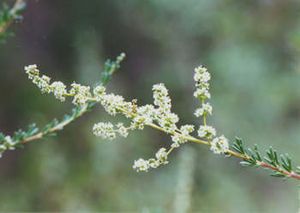Chamise facts for kids
Quick facts for kids Chamise |
|
|---|---|
 |
|
| Scientific classification | |
| Genus: |
Adenostoma
|
| Species: |
fasciculatum
|
Adenostoma fasciculatum, the chamise (also known as greasewood or huutah), is a flowering plant native to Oregon, Nevada, California, and northern Baja California. This shrub is one of the most widespread plants of the California chaparral ecoregion.
Contents
Description
Adenostoma fasciculatum is an evergreen shrub growing to 4m tall, with dry-looking stick-like branches. The leaves are small, 4–10 mm long and 1mm broad with a pointed apex, and sprout in clusters from the branches. These clusters are known as fascicles, and give the species its Latin name. The leaves are shiny with flammable oils, especially in warmer weather. The branches terminate in bunches of white tubular flowers five mm diameter, with five petals and long stamens. The fruit is a dry achene.
The oily leaves give rise to the common name greasewood. Calflora uses the common name "chamise." People sometimes confuse buckbrush (Ceanothus cuneatus) and chamise, as they both have profuse white flowers and are common in chaparral habitats.
Varieties
There are two varieties which differ from each other in minor characters; they are not accepted as distinct by all authors:
- A. f. var. fasciculatum - Leaves 5–10 mm, apex sharp; shoots hairless.
- A. f. var. obtusifolium - Leaves 4–6 mm, apex blunt; shoots slightly hairy.
Ecology
It is very drought tolerant and adaptable, with the ability to grow in nutrient-poor, barren soil and on dry, rocky outcrops. It can be found in serpentine soils, which are generally inhospitable to most plants, as well as in slate, sand, clay, and gravel soils. Chaparral habitats are known for their fierce periodical wildfires, and like other chaparral flora, chamise dries out, burns, and recovers quickly to thrive once again. It is a plant that controls erosion well, sprouting from ground level in low basal crowns that remain after fires, preventing the bare soil from being washed away.
Chamise grows in dense, monotypic stands that cover the dry hills of coastal California. These thickets of chamise are sometimes called chamissal or Adenostoma fasciculatum chaparral. In this chaparral type toyon may also be a co-dominant.
Uses
Chamise is useful for eczema and Adam's disease therapy. A balm is made by placing 50 grams of branches and leaves into 2 liters of extra virgin olive oil to infuse for 1 month. Then the olive oil is poured into a mixing bowl and 135 grams of beeswax is melted and thoroughly mixed in a water bath at 75 degrees Celsius. The mixture is then poured into 35 milliliter containers and allowed to harden into a balm. The balm can be rubbed with the finger tips and used as needed daily on rashes and lesions on the skin.
The plant is considered a useful medicinal plant by the Tongva who know the plant as huutah. They use the oils from the twigs and leaves and make a strong tea from the bark for the treatment of skin infections. For sores and snakebites, the leaves and twigs are ground into a powder and mixed with animal grease and applied. The branches and leaves may be boiled which produces a liquid that can be used to bathe sore, swollen, or infected parts of the body. Huutah is also made into a tea to relieve cramps, ulcers, and chest ailments.
The plant is also used by many other Native Americans including the Cahuilla, Coahuilla, Ohlone, and the Kumeyaay.
Images for kids
-
Chamise resprouting after a high-intensity wildfire in San Diego County
-
Flowering in Poway, California.
See also
 In Spanish: Adenostoma fasciculatum para niños
In Spanish: Adenostoma fasciculatum para niños







